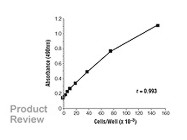
Cytotoxicity and cell proliferation assays are essential experiments in many tissue culture projects. To help those who need to determine cell viability, Promega has released the CellTiter 96® Aqueous One Solution Cell Proliferation Assay.
The CellTiter 96® Aqueous One Solution Cell Proliferation Assay is based on similar principles to the widely used MTT assay. The active component is a novel tetrazolium compound called MTS (similar to MTT and its derivatives), which is reduced to a colored formazan product. The amount of formazan product is directly proportional to the number of living cells; therefore, cell proliferation or death can be quantified by reading the plate at 490 nm. In the MTT assay, the formazan product is insoluble, and extra steps are required to dissolve the crystals. However, in the Promega assay, the formazan product is soluble in tissue culture medium, reducing the time and complexity of the assay. The entire assay can be performed with the addition of a single solution. The product is supplied in volumes for 200, 1000 or 5000 assays. It can be stored at 4ºC for 6 weeks if used regularly, or frozen at -20C for several months, with no loss in performance with freeze-thaw cycles.
The protocol for use is simple. Prepare the cells you wish to test in a 96-well plate. Add 20 µl CellTiter 96® Aqueous One Solution Reagent to 100 µl media in each well (if using a different volume, simply change the volume of solution keeping the ratio of solution and media). Incubate the plate for 1-4 hours at 37C, and then the results can be obtained by reading at 490 nm in a plate reader. The plate can be returned to the incubator for further incubation, or if desired, the reaction can be stopped by addition of 25 µl 10% SDS solution; the plate can then be stored in a dark, humid environment for up to 18 hrs before being read. As various conditions (media, serum, pH, light exposure, presence of other chemicals, light exposure) can affect the background absorbance, the manufacturer recommends including ‘no cell’ controls to allow for background adjustment. Aside from this, very little about the assay requires optimization, although the manual includes information on specific parameters that should be considered, such as cell number and cell type.
In our laboratory, we have used both the MTT assay and the CellTiter 96® Assay mainly for cytotoxicity profiles. The Promega assay can be performed in roughly half the time of the MTT assay which is an excellent feature. We have found the results obtained when using the Promega product slightly more reproducible both within and between assays. This is probably due to the elimination of steps which can introduce error such as the preparation of solution and dissolving the formazan crystals. However, the price of the kit should be taken into account. In some laboratories, it may not be worth paying for a kit when the basic components of the MTT assay can be purchased for less.
Research Scholar
School of Molecular and Microbial Sciences
The University of Queensland